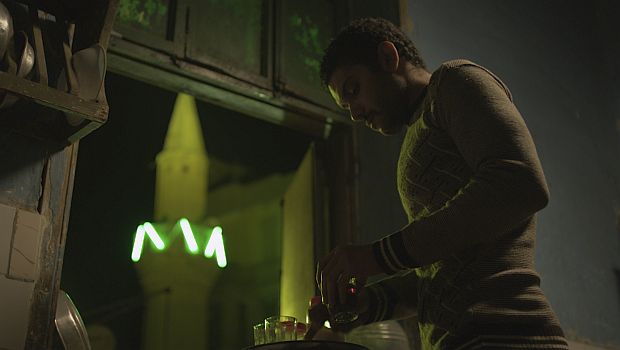
An image taken from Ahmad Abdalla’s Rags and Tatters. (Asharq Al-Awsat)
London, Asharq Al-Awsat—Since 2011 the London Film Festival has always included films that reflect on the Arab Spring. These included the portmanteaus 18 Days, and Tahrir 2011: The Good, the Bad, and the Politician, as well as Ibrahim El Batout’s Winter of Discontent in 2012. This year, another three films are being showcased in what represents a leap forward in this new political genre: The Arab Spring movie.
The three films—one from Syria and two from Egypt—cannot be more different from one another in terms of style, content, and tone. Acclaimed Syrian film director Mohamad Malas brings us Ladder to Damascus, his first film in ten years: a beautiful but surreal look at the current political upheaval in Syria. Moving between dream and drama, imagery and imagination, danger and desire, the film questions just what truly the Syrian people want? How deep does their desires go? What does freedom actually mean?
The film centers on a young acting student, Ghalia, who has fallen in love with a young filmmaker. There are news of protests erupting across Syria; they remain distant, but moving closer by the day. To pursue her dream, Ghalia rents a room in a house inhabited by a number of young, free-spirited artists and writers. The dynamism of this house—whose inhabitants include a Palestinian boxer, a Syrian-Sunni philosopher, and a Syrian-Orthodox sculptor—serves as a microcosm of Syrian society: an eclectic mix of people each with their own dreams and desires.
The story moves between the euphoria of the people—finally rising up against the government—and the vicious reality that the situation has become. This continuous blur moves back and forth between the cinematic dreamscape and the violent nightmares caught on civilians’ camcorders. The young filmmaker’s father urged his son to go out and “film everything,” despite the danger that threatens anyone caught with a camera. Despite this, the people are issuing their demands: One headline reads, “Intellectuals Face the Monster of Fear,” next to the incomplete phrase “The People Want…”
In his signature style of looking at life through reverie, Malas encapsulates today’s uncertainties about sectarian identity, politics, and violence, while the human spirit straddles it all. Ladder to Damascus stands as a timeless film that avoids any finite questions or answers and simply explores the motivation behind uprisings.
Electro Chaabi is an electrifying documentary by Tunisian-director, Heba Meddeb, exposing the Mahragan, a kind of music-event or gathering that has become increasingly popular in Cairo over the past two years. Mahragans are street parties that grow out of weddings but which are closer to resemble punk raves. These young men’s energetic style mixes heartfelt lyrically provocative rap with electro-beats and synthesized vocals; both the events and the sound are becoming an emblem of Egyptian youths freedom.
With a subject as sonically charged as this, it is hard to go wrong. The documentary follows the musical paths of a number of different performers including DJ Sadat 73, Amr 7a7a, Wezza and, most closely, the duo Oka and Ortega. As Meddeb joins them at the parties, their families’ homes, and around the city at night, we hear the young men talk about how things may have changed for them in spirit, the situation remains virtually the same as before in terms of social welfare. While Egypt is still struggling to find its way forward, Electro Chaabi shows that life has gone on, and politics has seeped into the everyday conscience. The lyrics sway between female relations in a conservative society, police aggression on the streets, and the death, violence, and rage that has come out of the uprisings.
Electro Chaabi does not delve directly into the January 25 revolution, instead it is a refreshing byproduct. By keeping the politics on the periphery, the film successfully presents the current reality in Cairo for Egypt’s youth, without viewing this through the over-used lens of the “Arab Spring.”
On the other end of the pole is Ahmad Abdalla’s latest feature Rags and Tatters. This near-silent, slow-burn docu-drama follows a man who was among those that were inexplicably evacuated from prison in Egypt in January 2011. His mission is to somehow show the world—via the mobile phone footage on his deceased friend’s phone—how the government provoked sectarian fighting.
The narrative of this film does not reveal much to the viewer, all the dialogue is indirectly picked up from bits of media being heard in the background. The audience’s understanding of the film depends on what they know of the political and social situation in Cairo. While the nameless protagonist travels—hiding like a fugitive—from Cairo’s mainly Muslim-inhabited “City of the Dead” to the Christian dominated “Garbage City.” The film brings the audience into the poorest areas of Cairo, far-away from the center of the upheaval at Tahrir Square.
Rags and Tatters presents some crucial ideas, challenging the now celebrated role of the Egyptian army and reminding people not to forget what they saw throughout the uprising. While it also makes some banal points, such as highlighting the importance of civilian media throughout the last two years. While the film had a positive element of looking past the elation following January 25 and focusing on the reality of the violence and sectarianism, the story lacked any real substance which would allow audiences to understand and invest in the characters portrayed on the screen.
At this point in post-Arab Spring film-making, the docu-drama genre, with its tropes of handheld video incorporated into narratives of either the upside or downside of revolution, has largely failed to live up to its potential. Ladder to Damascus and Electro Chaabi, however, show that what people are currently feeling, and the direction that society is heading in post-Arab Spring, are now the major focus, rather than remaining fixed on a stagnant moment in 2011, even if the repercussions of this are on-going.
